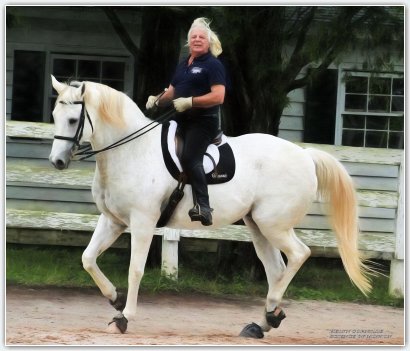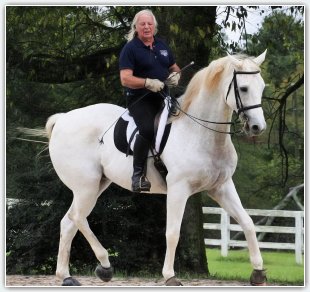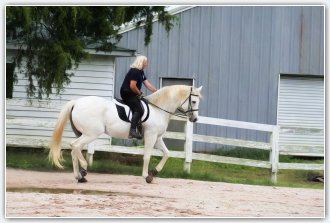Chazot 51
Chazot Thoughts 51

“Proper functioning of the locomotor system depends on precise synchronization of the movement of each part on every other part and in relation to the body as a whole.” (James R. Rooney, Biomechanics of lameness in horses, 1969)
The aim of this 2015 International Conference, was about knowledge of the most advanced scientific studies and the practical application of new knowledge. I was there, demonstrating the practical application of new knowledge. His approach is always explaining why classic authors arrived to the theories that they promoted and how these theories need to be reformulated and differently interpreted in the light of new knowledge. He asked me to perform shoulder in explaining that some authors advised shifting the rider’s weight over the outside seat bone while other authors peached shifting the weight over the inside seat bone. Adding the gest to his words, he shifted his weight over the outside seat bone and then over the inside seat bone and I hated it. He apologized to me touching my neck with his fingers and came back in his usual balance where his body weight is evenly distributed over both seat bones.
I wondered why a rider would disturb our vertebral column mechanism shifting the weight over one seat bone or the other, but he was explaining to the participants of the third International Conference that these theories have been created before scientific studies and in particular the work of Jean Marie Denoix, exposed the fact that our thorcolumbar column always associates a transversal rotation with any lateral bending. When we bend our thoracic spine, proper mechanism of our vertebral column demands that we rotate our dorsal spinous processes toward the inside of the bend. When, for his demonstration, he shifted his body weight over his inside seat bone, he was no longer is vertical balance with me and I contacted my back. We shift our dorsal spines toward the inside of the bend but it is not a large rotation, in the absolute, our dorsal spines remain almost vertical and the artificial shift of his body weight was disturbing.
Then, he shifted his body weight over his outside seat bone and it was very uncomfortable. I resisted the tendency of my thoracic spine to associate lateral bending with an inverted rotation but it was really what his body weight shifted over his outside seat bone suggested me to do. Inverted rotation occurs when we shift our dorsal spinous processes toward the outside of the bend. It is not particularly comfortable because such inverted rotation induces sharing forces on the articular surfaces of our vertebral bodies and we protect our vertebrae contracting the surrounding muscles.
As we walk or trot, our thoracic vertebrae bend alternatively right with the retraction of our right front leg, and left with the movement back of our left front leg. Each lateral bending is associated with a transversal rotation shifting our dorsal spinous processes toward the inside of the bend. Only a few of our thoracic vertebrae are capable of such rotation. Mostly, transversal rotations occur between our 14th forward to 9th thoracic vertebrae. Theoretically, if we were absolutely symmetrical in our muscular development, the rotations of our thoracic spines would be absolutely equal right and left of a hypothetical vertical line. In reality, we are never perfectly symmetrical and the rotations always occur preferential in one direction over the other. Manchester for instance, explained me when he arrived at the center, that he was not capable to bend left because his back muscle were so imbalanced that his thoracic vertebrae were only capable to rotate in one direction. I asked him why he was doing that and he told me, “I am a horse. I cannot analyze my own body. I can only protect what I feel is a problem. No one until him ever addressed my problem of transversal rotation. In fact they did not even know that such rotation existed. It was the root cause of my left stifle problem but not one addressed it. He did, and I was amazed to realize how easy it was for me to bend left as well as right.”
Other times, the rider provokes inverted rotation. Caesar explained that his previous rider bended his neck laterally right and left thinking that these lateroflexions would supple up his neck. “Each time he bended my neck in one direction, I had to shift my weight on my outside shoulder shifting my dorsal spines toward the outside of the bend. He was thinking suppleness and achieving in fact protective reflex contraction of my back muscles. My former rider never went beyond superficial equitation and in his mind, bending my neck to the right should incite me to turn right. I was talking about the guessing game the other day and that was a classical case. What my rider bended my neck to the right, expecting a right turn, he was shifting my weight over my left shoulder suggesting a left turn. I had to figure that what I was supposed to do was the opposite of what his so-called ‘aids’ suggested.”
Back in the barn after my demo, I asked to Caesar, how did you do shoulder in with a rider shifting his weight on the outside seat bone? Caesar responded, “I did not do shoulder in. I moved side ways with my body forming more or less an angle of 30° with the rail and my legs traveling on three tracks. I meet the judging standards but my back was crooked and I coupled in each direction lateral bending of my thoracic spine and inverted rotation. I ended hating the move because it was uncomfortable and I never felt any benefit. When I came here and he taught me how to coordinate lateral bending of my thoracic spine with the proper rotation I was amaze to find the move quite comfortable. As long as I was combining lateral bending with inverted rotation of my thoracic vertebrae, the adduction of my inside hind leg induced strain on the ligaments of my stifle. I am a strong guy so I did not became lame, at the least not for that, but I can see why the move was so painful for Manchester and why the shoulder in damaged him so badly. I even started liking the move because it helped me to increase the decelerating activity of my hind legs and consequently reducing the load on my forelegs. As you know, I developed arthritis between my second phalange and my coffin bone and it always felt good when the gymnastic that he was doing with me unloaded the weight on my front legs.”
During the demo,  he had a microphone explaining my reactions and how we interacted together.
he had a microphone explaining my reactions and how we interacted together. He used two quotes, One from Morihei Ueshiba, who creates Aikido, “Ultimately, you must forget about technique. The further you progress, the fewer teaching there are. The great path is really no path.” The other from Albert Einstein, “After a certain high level of technical skill is achieved, science and art tend to coalesce in esthetics, plasticity, and form. The greatest scientists are always artists as well.” He explained, “aids” are just teaching tools designed to make you take conscience of how different part of your body influence us. Aids are not the finality; they are just a teaching tool. The finality is that all these individual aids became a body language aiming at creating proper synchronization of the movement of each one of our body part on every other part and in relation to our body as a whole. All these gestures are in fact disturbing as they focus on one part of our body without properly orchestrating the other parts. Manchester commented, “The problem with their approach is that they believe that we will naturally coordinate our whole body around their inside leg, outside rein, or other aids. They don’t realize that living in the moment. We always initially protect whatever muscle imbalance or even bad habit that we have. We yield to their leg but with a crooked spine. They don’t have a clear picture of how our body, as a whole, has to be coordinated in order for us to adduct our inside leg or other move. He learned the correct aids like everybody else but studying how our body function and the complexity of how our body functions, he realize that the concept, ‘Correct aids equal correct movement’ was a kindergarten theory aiming at creating a highly sophisticated coordination of our physique. He understood that a more subtle and refined language was necessary. He does not apply aids; he talks to us with his entire body guiding our brain toward the coordination of our whole physique precisely adapted to the athletic demand of the move. There is no gesture. It is all about nuances in muscle tone that we feel as energy. Science and art coalesce. The science is that through sound understanding of our biomechanics, there is no submission, and other demeaning obedience. His capacity of analysis guides our brain toward efficient processing. We learn how to master our physique at a level that we could not achieve by our own. It is where we feel that we became artists. We further our athletic abilities and the ease that we experience allows us to add our personal style. I am not a great performer but for me soundness is a great performance and I do it with style. “
He used two quotes, One from Morihei Ueshiba, who creates Aikido, “Ultimately, you must forget about technique. The further you progress, the fewer teaching there are. The great path is really no path.” The other from Albert Einstein, “After a certain high level of technical skill is achieved, science and art tend to coalesce in esthetics, plasticity, and form. The greatest scientists are always artists as well.” He explained, “aids” are just teaching tools designed to make you take conscience of how different part of your body influence us. Aids are not the finality; they are just a teaching tool. The finality is that all these individual aids became a body language aiming at creating proper synchronization of the movement of each one of our body part on every other part and in relation to our body as a whole. All these gestures are in fact disturbing as they focus on one part of our body without properly orchestrating the other parts. Manchester commented, “The problem with their approach is that they believe that we will naturally coordinate our whole body around their inside leg, outside rein, or other aids. They don’t realize that living in the moment. We always initially protect whatever muscle imbalance or even bad habit that we have. We yield to their leg but with a crooked spine. They don’t have a clear picture of how our body, as a whole, has to be coordinated in order for us to adduct our inside leg or other move. He learned the correct aids like everybody else but studying how our body function and the complexity of how our body functions, he realize that the concept, ‘Correct aids equal correct movement’ was a kindergarten theory aiming at creating a highly sophisticated coordination of our physique. He understood that a more subtle and refined language was necessary. He does not apply aids; he talks to us with his entire body guiding our brain toward the coordination of our whole physique precisely adapted to the athletic demand of the move. There is no gesture. It is all about nuances in muscle tone that we feel as energy. Science and art coalesce. The science is that through sound understanding of our biomechanics, there is no submission, and other demeaning obedience. His capacity of analysis guides our brain toward efficient processing. We learn how to master our physique at a level that we could not achieve by our own. It is where we feel that we became artists. We further our athletic abilities and the ease that we experience allows us to add our personal style. I am not a great performer but for me soundness is a great performance and I do it with style. “
Chazot.


